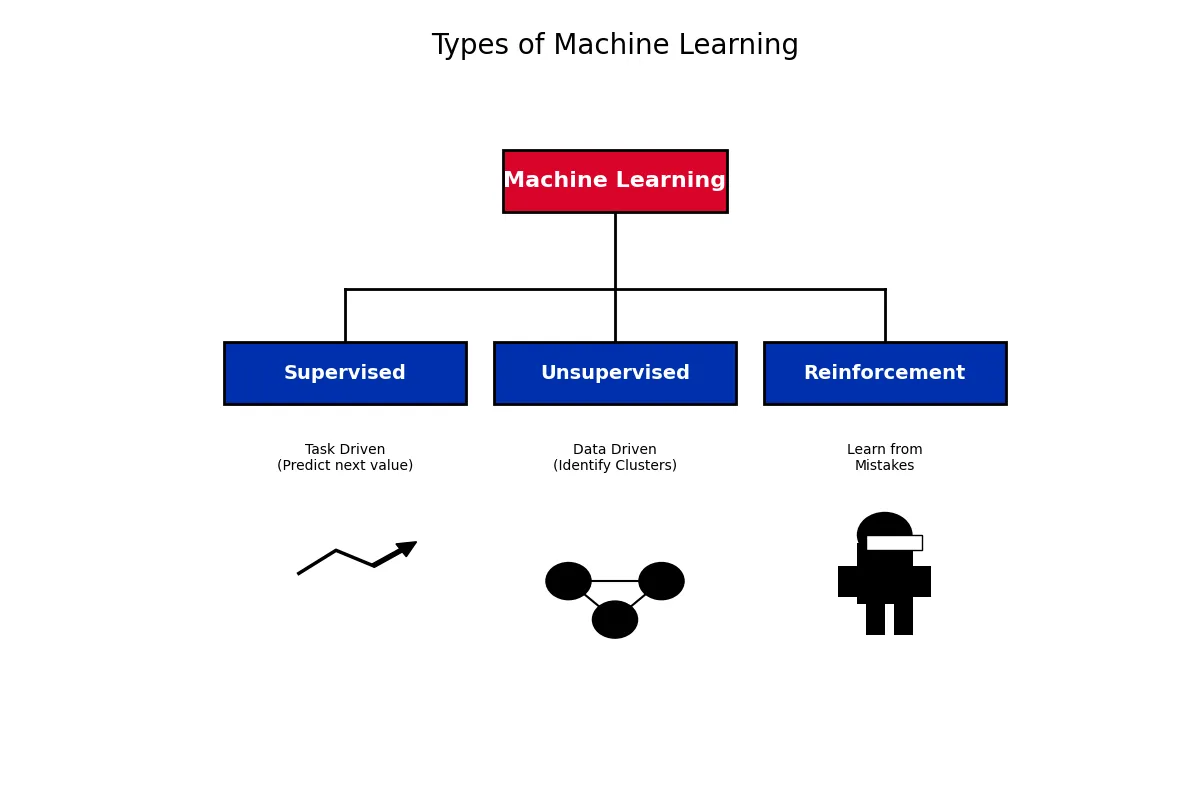Machine Learning
Machine learning is about teaching computer programs to improve at tasks through experience. Instead of programming explicit rules for every situation, we show algorithms examples and let them discover patterns in data.
There are three main approaches to machine learning: supervised learning, unsupervised learning, and reinforcement learning. Each works differently and suits different types of problems.

Each type addresses different kinds of problems and works with different data requirements.
Supervised Learning
Supervised learning works like teaching with examples and answers. You show the algorithm many input-output pairs, and it learns to predict outputs for new inputs it hasn’t seen before.
The algorithm learns by comparing its predictions to the correct answers. Over time, it gets better at finding patterns that connect inputs to outputs. Once trained, it can make predictions on new data.
Common examples you encounter:
- Email Spam Filtering: Email systems learn to identify spam by training on thousands of emails labeled as spam or legitimate.
- Advertisement Targeting: Algorithms predict which ads you might click based on your browsing history and demographics.
- Face Recognition: Social media platforms use tagged photos to learn who appears in new images.
Unsupervised Learning
Unsupervised learning works without correct answers. Instead, algorithms analyze data to find patterns, group similar items, or discover structure that wasn’t obvious before.
This approach is useful because most real-world data doesn’t come with labels. Unsupervised algorithms can process large amounts of data to find patterns that might not be obvious to humans.
Examples include:
- Recommendation Systems: Netflix and YouTube analyze viewing patterns to suggest content, even without explicit ratings.
- Customer Segmentation: Companies group customers by purchasing behavior for targeted marketing.
- Problem Identification: Tech companies automatically group similar bug reports to identify common issues.
Reinforcement Learning
Reinforcement learning works through trial and error. An algorithm tries different actions in an environment and learns from the consequences, getting rewards for good choices and penalties for poor ones.
This mirrors how many animals learn: through consequences. Good behavior gets rewards, bad behavior gets correction.
Consider an algorithm learning to play Mario:
- Agent: The learning algorithm
- Environment: The game world
- Actions: Controller inputs (jump, run, etc.)
- State: Current game screen
- Reward: Points gained or lost
The algorithm tries different button combinations, sees what happens, and gradually learns strategies that lead to higher scores.
Real applications include:
- Game AI: AlphaGo and similar systems learned to play complex games through self-play.
- Robotics: Factory robots learn assembly processes through trial and error in simulated environments.
- Resource Management: Google uses reinforcement learning to manage data center cooling, reducing energy costs.
Putting It Together
In practice, these approaches often work together. Many real systems combine different learning methods depending on the problem and available data.
For example:
- A game AI might use supervised learning to recognize objects and reinforcement learning for strategy
- A language model might learn word relationships without supervision, then improve with supervised training
- A recommendation system could group users without labels, then use supervised learning to predict preferences
These three approaches cover most machine learning applications. Understanding them helps explain how the AI systems we use daily actually work, whether it’s email filters, recommendation engines, or game-playing algorithms.
Machine learning is pattern recognition and learning from data, not magic. The more we understand these basics, the better we can work with and build these systems.
